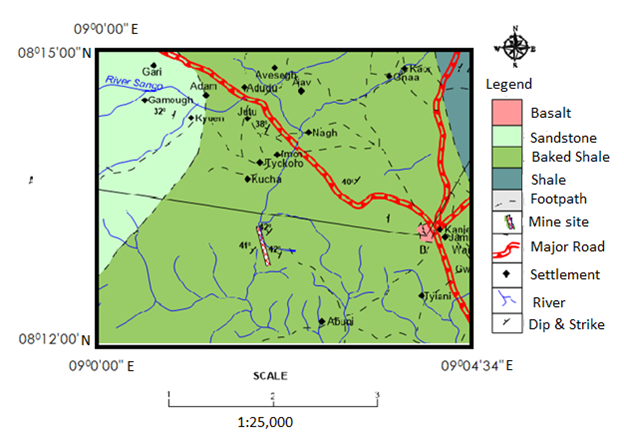Geobotanical and Biogeochemical Prospecting Method of Complex Sulphide Ore of Pb-Zn-Cu-Ba in Abuni-Adudu areas of the Middle Benue Trough, Nigeria
Keywords:
Anogeissus leiocarpus DC, Biogeochemistry, Dichrostachys cinerea, Geobotany, Lead-Zinc-Copper oreAbstract
This research work focused on two plant species namely, the Anogeissus leiocarpus (DC.) and Dichrostachys cinerea for mineral prospecting. The two plants were sampled based on their occurrence, abundance and outlook. Twelve samples (six each of Anogeissus leiocarpus (DC.) and Dichrostachys cinerea) were collected around Abuni-Adudu mining communities in the Middle Benue Trough, Nigeria. In addition, bulk ore and twelve soil samples were also collected and analysed for correlation. Geologically, the study area is made up compacted shale, baked shale (hornfels), and sandstones of sedimentary origin, which are intruded by tertiary basalts of igneous origin. Samples were analysed for elemental composition, using inductively coupled plasma mass spectrometry method. Analysis revealed that the geobotanical method of prospecting for Pb-Zn-Cu-Ba mineralization in the area is promising as biogeochemical data indicated that the Dichrostachys cinerea are good indicator of Pb-Zn-Cu mineralization while the Anogeissus leiocarpus were indicative of Barium. Given the relatively low concentration of Barium in the ore (3.8 ppm) as against concentration in the soil samples, which ranges from 83 ppm (sample YS6) to 552 ppm (sample YS12), Barium has its source from the shale and sandstone or nearby Barite mineralization and not the ore.

Published
How to Cite
Issue
Section
Copyright (c) 2023 Oyesiji Cornelius Oyeyemi, Shekwonyadu Iyakwari, Stephen Ewoma Obrike, Nanlir Geoffrey Jangfa

This work is licensed under a Creative Commons Attribution 4.0 International License.
How to Cite
Most read articles by the same author(s)
- Nuhu Degree Umar, Shekwonyadu Iyakwari, Radiotoxicity and groundwater quality for drinking in a multi-layered saline sedimentary terrain of Keana, Central Benue trough, Nigeria , African Scientific Reports: Volume 3, Issue 2, August 2024




